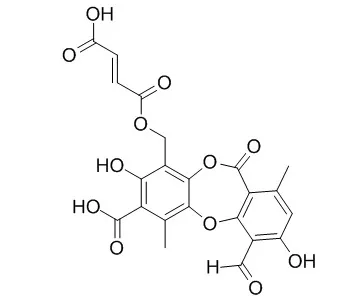| Description: |
Fumarprotocetraric acid has expectorant, antioxidant, antimicrobial , and allelopathic properties. It shows inhibitory activity against enzymes such as tyrosinase, a key agent in melanin biosynthesis. |
| Targets: |
Tyrosinase | Antifection |
| In vitro: |
| Tropical Bryology,1999,17:133-139. | | Allelopathic effect of the Cladonia verticillaris lichen extracts and fumarprotocetraric acid on the early growth of germinated seedlings in Allium cepa L.[Reference: WebLink] |
METHODS AND RESULTS:
The allelopathic activity of the different type of Cladonia verticillaris lichen extracts and Fumarprotocetraric acid on the early growth of A. cepa (IPA 6) germinated seedlings depends on their chemical composition and concentration, respectively. It was observed that the length of the radicle was significantly stimulated by Fumarprotocetraric acid at high concentrations and by the total extract of C. verticillaris thalli, which contained high level of fumarprotocetraric, acid confirmed by HPLC – technique. In addition, it was found, that the phosphate buffer extract, which contained high level of methy b-orcinol carboxilate measured by HPLC, significantly reduced the length of the hypocotyls. Under our experimental conditions there was no influence of different type of extract and Fumarprotocetraric acid on the seed germination ratio of A. cepa, in relation to control.
CONCLUSIONS:
From the study of HPLC it was found that Fumarprotocetraric acid and methy b-orcinol carboxilate were present in all extracts at different concentrations, according to the method of extraction. | | The Electronic Journal of Chemistry,2017,9(4). | | Effects of Fumarprotocetraric Acid, a Depsidone from the Lichen Cladonia verticillaris, on Tyrosinase Activity.[Reference: WebLink] | Lichens are widely distributed around the world. Their phenolic compounds, consisting mainly of depsides and depsidones, have been extensively studied for important biological activities. More recently, these compounds have been evaluated for their inhibitory activity against enzymes such as tyrosinase, a key agent in melanin biosynthesis.
METHODS AND RESULTS:
In the present investigation, the depsidone Fumarprotocetraric acid isolated from the lichen Cladonia verticillaris (Raddi) Fr. was evaluated for its inhibitory activity against this critical enzyme. Kinetic study showed that depsidone at 0.6 mM inhibited tyrosinase activity by 39.8%.
CONCLUSIONS:
Lineweaver–Burk plots revealed that Fumarprotocetraric acid can act as an uncompetitive or mixed-type inhibitor, depending on concentration. |
|
| In vivo: |
| Pulmonary Pharmacology & Therapeutics, 2014, 27(2):139-143. | | Expectorant and antioxidant activities of purified fumarprotocetraric acid from Cladonia verticillaris lichen in mice.[Reference: WebLink] | The lichen Cladonia verticillaris produces bioactive secondary metabolites, such as fumarprotocetraric (FUM) and protocetraric acids. Species of the genus Cladonia demonstrate anti-tumor, anti-inflammatory and antipyretic activities and have been used in folk medicine to treat respiratory diseases (throat irritation, cough, asthma and tuberculosis). The aim of the present study was to evaluate the expectorant and mucolytic activities of Fumarprotocetraric acid in albino Swiss mice.
METHODS AND RESULTS:
FUM was extracted and purified from an acetone extract of C. verticillaris. The phenol red quantification method was used on the bronchoalveolar lavage fluid following the administration of FUM (25, 50 or 100 mg/kg orally or intraduodenally and 12.5, 25 or 50 mg/kg, intraperitoneally) for the evaluation of expectorant activity. Control groups received either saline solution (7.5 mL/kg) or ambroxol (1 mg/kg) through the same administration routes. Antioxidant activity was evaluated using the thiobarbituric acid reactive species assay in mouse lung tissue treated with the FUM at 25, 50 or 100 mg/kg orally, followed by a lipopolysaccharide solution at 1 mg/kg intrapleurally. The same protocol was used for the control groups using either saline solution (7.5 mL/kg, orally) or N-acetylcysteine (20 mg/kg, orally). Results: Orally administered FUM at doses of 25 and 50 mg/kg promoted significantly greater dose-dependent phenol red activity in the bronchoalveolar lavage and expectorant activity in comparison to the controls (p < 0.05). Lipid peroxidation (malondialdehyde equivalent) was reduced by 50% in the lung tissue.
CONCLUSIONS:
The results confirm the expectorant and antioxidant properties of Fumarprotocetraric acid produced by the lichen C. verticillaris. |
|






 Cell. 2018 Jan 11;172(1-2):249-261.e12. doi: 10.1016/j.cell.2017.12.019.IF=36.216(2019)
Cell. 2018 Jan 11;172(1-2):249-261.e12. doi: 10.1016/j.cell.2017.12.019.IF=36.216(2019) Cell Metab. 2020 Mar 3;31(3):534-548.e5. doi: 10.1016/j.cmet.2020.01.002.IF=22.415(2019)
Cell Metab. 2020 Mar 3;31(3):534-548.e5. doi: 10.1016/j.cmet.2020.01.002.IF=22.415(2019) Mol Cell. 2017 Nov 16;68(4):673-685.e6. doi: 10.1016/j.molcel.2017.10.022.IF=14.548(2019)
Mol Cell. 2017 Nov 16;68(4):673-685.e6. doi: 10.1016/j.molcel.2017.10.022.IF=14.548(2019)